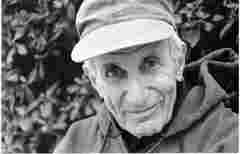 Neely Bruce informs me that the great Henry Brant has died within the last few hours. He was a phenomenally creative figure, though one hard to wrap one’s ears around, because his specialty was spatial music; his works, often involving multiple ensembles separated by distance, were too enormous to stage often, and recordings hardly do them justice. I was privileged to have heard his 500: Hidden Hemisphere live, a mammoth piece in celebration of Columbus for three wind ensembles and steel drum band, placed around the fountain at Lincoln Center in 1992. He was born in Montreal, and thus Canada gets to claim him, but his primary inspiration was Charles Ives, and he began composing for instruments widely separated from each other in an attempt to clarify dense, Ivesian polyphony. Even when not writing spatially he composed for unconventional ensembles, like the ten variously sized flutes of his delightful Angels and Devils (1931), or his Orbits (1979) for 80 trombones, organ, and sopranino voice. A work called Fire on the Amstel employs four boatloads of 25 flutes each, four jazz drummers, four church carillons, three brass bands, three choruses, and four street organs. Live performances of it remain rare, for some reason. His reputation as an incredible orchestrator (he made part of his living doing filmscores from the 1930s through ’60s, but didn’t like to talk about them) was confirmed with his 1994 orchestration of Ives’s Concord Sonata, titled A Concord Symphony, a splendid reimagining of a great work.Â
Neely Bruce informs me that the great Henry Brant has died within the last few hours. He was a phenomenally creative figure, though one hard to wrap one’s ears around, because his specialty was spatial music; his works, often involving multiple ensembles separated by distance, were too enormous to stage often, and recordings hardly do them justice. I was privileged to have heard his 500: Hidden Hemisphere live, a mammoth piece in celebration of Columbus for three wind ensembles and steel drum band, placed around the fountain at Lincoln Center in 1992. He was born in Montreal, and thus Canada gets to claim him, but his primary inspiration was Charles Ives, and he began composing for instruments widely separated from each other in an attempt to clarify dense, Ivesian polyphony. Even when not writing spatially he composed for unconventional ensembles, like the ten variously sized flutes of his delightful Angels and Devils (1931), or his Orbits (1979) for 80 trombones, organ, and sopranino voice. A work called Fire on the Amstel employs four boatloads of 25 flutes each, four jazz drummers, four church carillons, three brass bands, three choruses, and four street organs. Live performances of it remain rare, for some reason. His reputation as an incredible orchestrator (he made part of his living doing filmscores from the 1930s through ’60s, but didn’t like to talk about them) was confirmed with his 1994 orchestration of Ives’s Concord Sonata, titled A Concord Symphony, a splendid reimagining of a great work.Â
Henry Brant (1913-2008)
Brant was an odd character, always wearing a visor, bristling with energy, and not liking to sit down at public appearances. I interviewed him on the phone once and met him briefly, but didn’t get to know him or his music as well as I would have liked. Combining diatonic, Roy Harris-y harmonies, frequent quarter-tones, and massive clusters in the most radical performance situations, he was a curious amalgam of mid-century populism and the post-Cage avant-garde. His output remains a discovered but yet unexplored musical continent.
